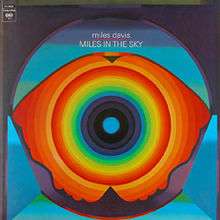Miles in the Sky
Miles in the Sky is a studio album by American trumpeter and composer Miles Davis, released on July 22, 1968, by Columbia Records.[1]
Background
Miles in the Sky was produced by Teo Macero and recorded at Columbia Studio B in New York City on January 16, 1968, and May 15–17, 1968.[2] For the album, Davis played with tenor saxophonist Wayne Shorter, pianist Herbie Hancock, drummer Tony Williams, and bassist Ron Carter.[2] Guitarist George Benson made a guest appearance on the song "Paraphernalia".[3] The album's title was a nod to the Beatles' 1967 song "Lucy in the Sky with Diamonds".[1]
Composition
For Miles in the Sky, Davis and his quintet pulled further away from conventional jazz and more toward jazz-rock fusion. The album's compositions are extended and groove-oriented, and mostly have rhythms with simple 4
4 time signatures from rock music, which are embellished by Hancock's electric piano.[3] According to All About Jazz's C. Michael Bailey, Miles in the Sky is one of six albums by Davis' quintet between 1965 and 1968 that introduced the poorly defined jazz subgenre post-bop.[4]
Critical reception
In a contemporary review, Down Beat magazine called Miles in the Sky one of the best albums by Davis and his second quintet because of how it shows he had been influenced by Ornette Coleman and John Coltrane: "even as Miles denies it, for their assault on the popular song has pushed Miles along the only path that seems open to him, an increasingly ironic detachment from sentiment and prettiness".[2]
In a retrospective review for Allmusic, Stephen Thomas Erlewine found it less adventurous than Nefertiti (1968): "Intriguing, successful jams in many respects, but ... this is less visionary than its predecessor and feels like a transitional album – and, like many transitional albums, it's intriguing and frustrating in equal measures."[3] Hernan M. Campbell of Sputnikmusic was more enthusiastic and praised the musicianship throughout, particularly that of Williams, whose drumming he found "mind-blowing". Campbell felt that Miles in the Sky should not be overlooked because it marked the beginning of Davis' electric period and was one of the defining jazz fusion albums.[6]
Track listing
Original LP
1998 reissue bonus tracks
|
| 5. | "Black Comedy [Alternative Take]" | Williams | 6:26 |
| 6. | "Country Son [Alternative Take]" | Davis | 14:38 |
- Recorded on January 16 (No. 2), May 15 (No. 4), May 16 (No. 3) and May 17 (No. 1), 1968.
Personnel
References
- 1 2 "Miles Davis: Miles in the Sky". Sony Music Entertainment. Retrieved December 25, 2013.
- 1 2 3 4 "Miles Davis - Miles in the Sky CD Album". CD Universe. Archived from the original on November 21, 2010. Retrieved December 25, 2013.
- 1 2 3 4 Erlewine, Stephen Thomas. "Miles in the Sky - Miles Davis". Allmusic. Retrieved December 25, 2013.
- ↑ Bailey, C. Michael (April 11, 2008). "Miles Davis, Miles Smiles, and the Invention of Post Bop". All About Jazz. Retrieved February 23, 2013.
- ↑ RS Album Guide
- 1 2 Campbell, Hernan M. (March 8, 2012). "Review: Miles Davis - Miles In The Sky". Sputnikmusic. Retrieved December 25, 2013.
- ↑ Swenson, J. (Editor) (1985). The Rolling Stone Jazz Record Guide. USA: Random House/Rolling Stone. p. 58. ISBN 0-394-72643-X.
External links
|
|---|
|
|
|
| The Birth of the Cool (1945–1956) | |
|---|
|
| The Columbia Years (1956–1975) | |
|---|
|
| Later career (1981–1991) | |
|---|
|
| Live recordings | |
|---|
|
| Compilations | |
|---|
|
| Box sets | |
|---|
|
| Remix albums | |
|---|
|
| Compositions | |
|---|
|
| Related | |
|---|
|
|
